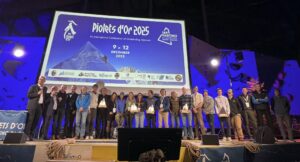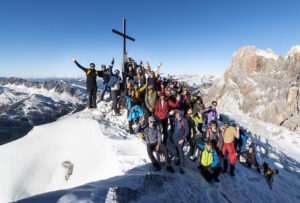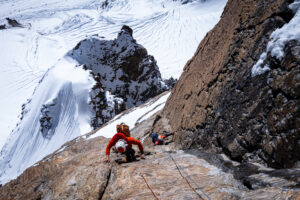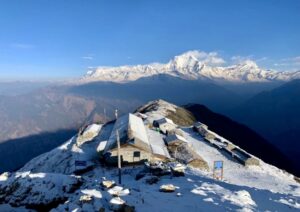From May 19 to May 23, Czech Piolet d’Or alpinist Marek Holecek and his partner Matej Bernat made the first ascent of the northwest face of 6,764m Sura Peak (also known as Hongku), in the Khumbu Himal in Nepal. They named their new route ‘Simply Beautiful’ (1,500m, M6, alpine-style).
The average slope of the climb was 70°, but in some places, it reached 90°. The elevation was 1,300 vertical meters and the pair spent four days on the mountain, bivouacking three times.

Base camp at night. Photo: Marek Holecek
More than a simple technical description
The story of a good mountaineering expedition is never just a technical description. Indeed, to revive an expedition, first, you climb the mountain with your crampons, then you climb it again with a pen and a notebook.

In the background: 6,764m Sura peak in the Khumbu Himal, Nepal. Photo: Marek Holecek
Back at home, Holecek has shared details of the Sura expedition with ExplorersWeb.
“To reduce the whole concept of mountain climbing to a mere athletic/gymnastic ‘position change’, i.e. moving from the valley to the top, would be highly disrespectful to my life philosophy, if not barbaric,” Holcecek explained. For him, mountaineering doesn’t involve summit hunting. “I don’t remember the summits, but [I do remember] the strong, hard, beautiful moments, and my climbing partners who helped me look down from the peaks”.

The beginning of the rock barrier. Photo: Marek Holecek
The idea is born
The expedition began to take shape two years ago when Holecek and Radoslav Groh opened a new route called ‘Heavenly Trap’ on the west face of 7,162m Baruntse. On that expedition, Holecek saw Sura Peak.
“For the past two years, the image of a nameless pyramid rising steeply above a glacier had been returning to me now and then when I closed my eyes. In my mind, I was picturing possible lines leading to the top. Nothing could be done against it,” Holecek said.

The first bivouac and a view of the wall. Photo: Marek Holecek
After Baruntse, Holecek started to research the climbing history of Sura Peak. Next, he sent messages to other climbers asking if anyone was interested in going with him. “Whatever the reason, after two months of searching, the column for ‘Climbing Partner’ was still empty,” Holecek recalls.
Bernat steps up
Holecek contacted climbing friends based on their skills and personalities. “During almost fifty expeditions, I have climbed with many friends, each of them a bit crazy in their way and focused on something of their own, but always enriching, determined, and great,” Holecek said.
Finally, Matej Bernat learned of the project and contacted Holecek to say he was interested.
This spring the pair traveled to Nepal where they spent two weeks training and acclimatizing in the central Himalayas before heading to Sura base camp.

On the first day, in the afternoon, approaching the ice barrier. Photo: Marek Holecek
Preparing for the climb
On May 13, they established a base camp on the sandy shore that surrounds a glacial lake at 5,500m. Holecek described it as “a fairy tale corner of the Himalayas, terrifying and desolate in one.”
A few days later they went to have a closer look at Sura. “There was only a little snow and the reliefs of dark rock and deep blue ice peeked out from the surrounding mountain walls,” Holecek wrote. Holecek compared the weather with his trip in the spring of 2021. Now it was colder and the cold persisted throughout the day.

Climbing under the rock passage. Photo: Marek Holecek
Their camp was located directly under the northwest face of Sura, their goal. From camp, they could see an icy slope of roughly 50° that became progressively steeper up to a forked glacial serac. Above the serac loomed an ominous overhanging dark rock face.

Climbing on the third day. Photo: Marek Holecek
The ascent
Holecek and Bernat left base camp on May 19, with everything they might need during the climb. The climbers considered five days enough for their return trip up the northwest face.

Selfie of Matej Bernat on the third morning. Photo: Matej Bernat
For the first section of the route they didn’t secure each other and the rope served only “as a silent connection.” They moved fast and gained height quickly. Shortly after noon, Holecek and Bernat reached the steepest part of the icy “slide” which crossed the threshold of the serac. Here, the slope was 80° and in some places rose into a vertical wall of blue ice. With increasing strain, their progress slowed, and the afternoon sun quickly drifted westwards.
Holecek and Bernat needed a break. During one diagonal traverse leading through a system of grooves that formed a connection to the ascent line, they reached a cave a little above 6,000m where they bivouacked overnight. “The cave must have been sent to us from heaven,” recalls Holecek.

The fourth bivouac was in an ice cave in the upper section. Photo: Holecek/Bernat
In deep shit
On the third day, the weather deteriorated drastically. In the morning the sun was shining, but soon after dark clouds arrived. The duo climbed another 150m, up ice flutes leading from their bivouac to a continuous rock barrier. “This was a predictable trouble,” Holecek explained.
The first few meters of this section proved that the rock structure was like gingerbread, sprinkled with loose snow. It was difficult for them to find support for their pointed tips. “It reminded me of the cartoon character Mickey Mouse trying to hold himself over an abyss with legs and arms spinning life propellers in the air,” remembers Holecek.

The rock passage. Photo: Marek Holecek
Securing themselves to the rock only had a psychological effect, they could hardly rely on it. When Holecek took the rope in, Bernat fell twice. Luckily, Holecek’s belay held firm and they didn’t plunge into the valley below.
Next, they needed to look for a place to spend the night. The terrain around them was hostile and viciously slanted, forcing them to dig into a 70° slope. “But even after twenty minutes of wild thrashing we didn’t celebrate victory. Under a few-centimeter-thick layer of ice, there was rock with the same slope. We were in deep shit with the whole circus,” recalls Holecek.
They had to attach the canopy of their tent to the belay on which they were hanging. The following day, day four, was the key to the entire ascent.
“Although we didn’t know if we could succeed in climbing the next meters of rock, it was crystal clear that if we didn’t, we would get into big trouble,” Holecek explained. There was no choice but to continue up because it was hard to imagine getting back through the places they had already ascended.
On the other hand, the 80m rock section above them looked like one huge overhang. “Each time when I am indecisive my inner voice whispers to me: ‘Just give it a try, give a focused valid attempt and you’ll see’,” Holecek told us.

The summit of Sura Peak. Photo: Marek Holecek
When fear has gone
The abyss to the foot of the glacier was about one kilometer deep, according to Holecek. But suddenly, “the fear was gone, there wasn’t any more space for fear,” he recalls. “I only felt the muscle fatigue. In my head, an alarm started buzzing to warn me that my mental strength was running out.”
Bernat took the lead for the next two icy lengths. After the second one, they found a crack on the 70° slope and made another bivy.

Matej Bernat (left) and Marek Holecek on the summit of Sura. Photo: Marek Holecek
On day five, less than two hours after leaving the bivouac, they climbed the last 140m to the summit.
“There was nowhere to climb further. No applause, no standing ovation. We forced our faces to squeeze out smiles that rather expressed the relieved joy that we no longer had to take another step higher. We hugged each other with a pat on the back. We quickly took out our cameras. Click…a moment of tape recording and the whole ceremony was over,” recalls Holecek.

Starting the descent. Photo: Marek Holecek
One climber’s memory
“I was looking at the frigid frozen beauty, trying to indelibly inscribe it in my memory. However, the image never lasts long before it starts to fade out and finally, it disappears completely,” Holecek explained. “The only thing that remains captured is the colorful memories of hardship, hard work, and the climbing partner with whom you underwent the martyrdom.”
Holecek contemplated the surrounding peaks from the summit of Sura, with tears on his face, remembering his past expeditions.

The never-ending ridge. Photo: Marek Holecek
During the descent, Bernat took the lead along the sharp ridge. Although the two Czechs were tied to a rope twenty meters apart, they were moving in the same rhythm. “A 1km deep chasm on both sides. Both are only pretending that we are secured,” recalls Holecek. It was an intense descent, but they returned to base camp safely.

Marek Holecek at base camp. The route is marked with a red line on the northwest face of Sura. Photo: Marek Holecek
“We called the climb ‘Simply Beautiful’. It was pure alpinism. A beautiful untouched face. No posh base camp with puppet staff. Only a few backup meals before we started. One battle tent, a backpack with gear, a rope like an umbilical cord, our plan and determination. Nothing useless. Then a battle for each step on the northwest face to the top and the rush back down, to life. My last words belong to Matej [Bernat]. Thank you!”

Marek Holecek (left) and Matej Bernat after the descent and back to civilization. Photo: Marek Holecek






